Zeta Ophiuchi (ζ Oph) is a hot blue subgiant star located 366 light-years away in the constellation Ophiuchus. With an apparent magnitude of 2.57, it is the third brightest star in the constellation, after Rasalhague and Sabik. Zeta Ophiuchi is the nearest O-type star to the Sun. It is one of the bright stars that outline the polygonal constellation figure of the celestial Serpent Bearer.
Star type
Zeta Ophiuchi is a massive blue subgiant star of the spectral type O9.2 IVnn. Some sources give it the stellar classification O9.5 V, indicating a hydrogen-fusing dwarf. Its mass of 20.2 solar masses determines its ultimate fate as a supernova. The star has a radius 8.5 times that of the Sun and is 74,100 times more luminous than our star, with an effective temperature of about 34,300 K. It has an estimated age of only 3 million years.
Even though it is still young, the hot star will expand into a red supergiant in the next few million years. When it does, its diameter will be greater than the orbit of Jupiter. The star will meet its end as a bright supernova, leaving behind a neutron star or pulsar.
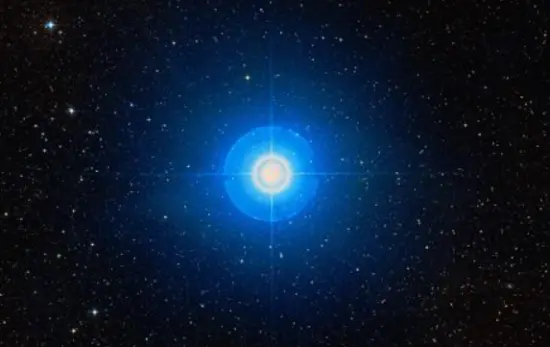
Zeta Ophiuchi, image: Wikisky
Zeta Ophiuchi is an exceptionally fast spinner, with a projected rotational velocity of up to 400 km/s. If it really spins this close to its breakup velocity, it takes a day to complete a rotation. Like most massive stars, Zeta Ophiuchi is losing mass through a powerful stellar wind that blows at about 1,600 km/s.
Due to the star’s fast rotation, its surface temperature is higher at the poles (39,000 K) than at the equator (30,700 K). The temperature varies because the star has an oblate shape due to its high spin rate, and the poles are closer to the centre of mass than the equator.
Zeta Ophiuchi is a variable star, classified as both a Gamma Cassiopeiae variable and a Beta Cephei variable. Its brightness varies from magnitude 2.56 to 2.58 with a period similar to that of a Beta Cephei-type star. Beta Cephei variables are pulsating stars that appear the brightest when they are the smallest and hottest. The brightest examples of this class are Beta Cephei in the constellation Cepheus, Mirzam in Canis Major, Hadar in Centaurus, Spica in Virgo, Mimosa in Crux, and Shaula in Scorpius.
Gamma Cassiopeiae variables vary in brightness due to intermittent shell episodes. These are hot stars with equatorial decretion disks that occasionally disappear and reform. The best-known stars in this class are the class prototype Gamma Cassiopeiae in the constellation Cassiopeia, Pleione in the Pleiades cluster in Taurus, and Kappa Canis Majoris in Canis Major.
In 1979, a team of astronomers discovered moving bumps in the helium line profiles of Zeta Ophiuchi. These were initially thought to be the result of rotational modulation, but later studies showed that they were more likely to be caused by non-radial pulsations of a high degree. The “moving bumps” have since been found in many OB and Delta Scuti-type stars. OB stars exhibiting these features have been called the Zeta Ophiuchi stars.
Facts
Zeta Ophiuchi is the nearest O-type star to Earth, as well as the brightest star in this spectral class.
The star is surrounded by a faint emission nebula catalogued as Sharpless 27 (Sh2-27). The extended H II region is a bow shock nebula produced by the star as it plows its way through an immense cloud of dust and gas.
Zeta Ophiuchi is a luminous star with a high space velocity, located in a dust-rich region of the Milky Way. It is losing mass through a stellar wind at a rate of about 1.1 x 10-7 solar masses per year, or one solar mass every 9 million years. As it keeps moving, the bright blue star creates a spectacular shock wave in the direction of its motion. The star’s strong wind is compressing the gas in its way and making the massive shockwave glow in infrared light.
The shockwave was revealed in a composite image that combined infrared data obtained with NASA’s Spitzer Space Telescope with X-ray data captured by NASA’s Chandra X-ray Observatory. Chandra detected a bubble of X-ray emission from the gas in the star’s path, heated to tens of millions of degrees by the effects of a shock wave. Managed by NASA’s Marshall Space Flight Center, the Chandra program helped unveil details about the star’s complicated past.
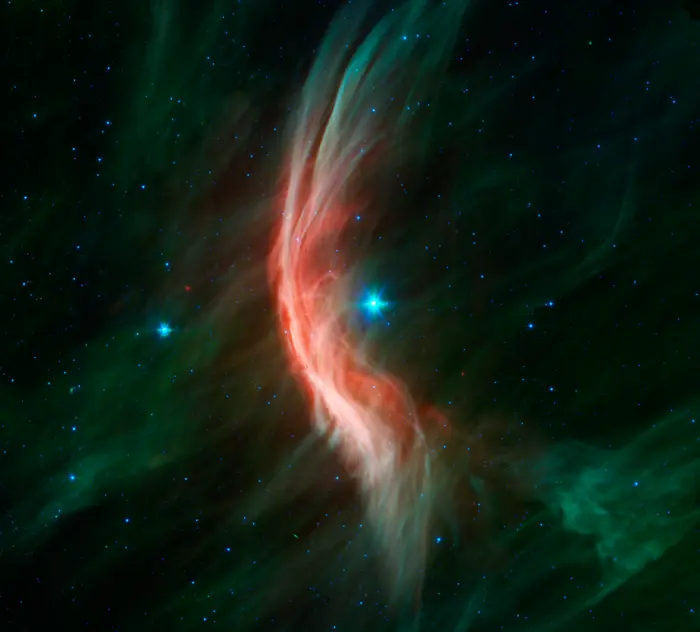
The giant star Zeta Ophiuchi is having a “shocking” effect on the surrounding dust clouds in this infrared image from NASA’s Spitzer Space Telescope. Stellar winds flowing out from this fast-moving star are making ripples in the dust as it approaches, creating a bow shock seen as glowing gossamer threads, which, for this star, are only seen in infrared light. Image: NASA/JPL-Caltech
The Chandra data and data collected by the Japanese Suzaku X-ray astronomy satellite were analyzed by a team led by Jesús Toala from the Institute of Astrophysics of Andalucia in Spain. The team investigated the presence of diffuse non-thermal X-ray emission associated with the star’s bow shock and found no trace of it. Additionally, none of the models fit the observed X-ray spectrum of the star. The best-fit model involved a two-temperature component (the plasma of the diffuse X-ray emission and the X-ray output of Zeta Oph). The findings indicated the existence of a mixing region between the shocked wind region and the ionized outer material.
Scientists led by Samuel Green from the Dublin Institute for Advanced Studies in Ireland used computational models of the star to better understand the data captured at different wavelengths, including optical, infrared, X-ray, and radio observations. They created detailed computer models of the bow shock using archival Chandra and Spitzer observations and found that all three different computer models of the shockwave predicted fainter X-ray emission than the one observed. The X-ray glow is brightest near the star and two of the three computer models predict that it should be brighter near the shock wave. The results of the study were published in the journal Astronomy and Astrophysics. The scientists plan to create more complicated models that will include the effects of turbulence and particle acceleration to better understand the X-ray data.
NASA’s Wide-field Infrared Survey Explorer (WISE) captured the bow shock in the infrared. The compressed material in the bow shock glows in infrared light but cannot be detected in the visible band.
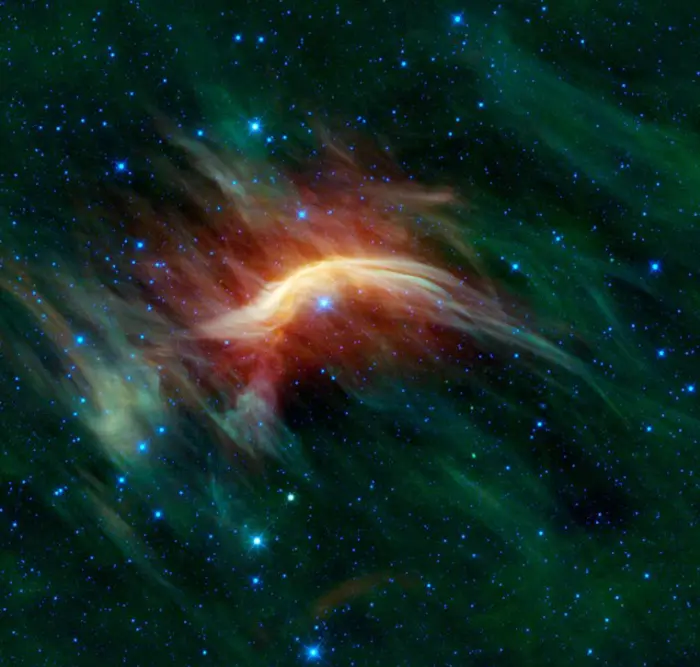
This infrared image from NASA’s WISE telescope shows the runaway star Zeta Ophiuchi as it creates a bright shockwave (yellow arc) in an interstellar dust cloud as it zooms through space. Image credit: NASA/JPL-Caltech/WISE Team
Zeta Ophiuchi is a runaway star, moving through space with a peculiar velocity of 30 km s-1. It was identified as a runaway in the 1950s because of its high proper motion and large velocity with respect to the surrounding interstellar matter. The high velocity is confirmed by the presence of the bow shock.
The age and proper motion of Zeta Ophiuchi suggest that the star is a member of the Upper Scorpius sub-group of the Scorpius-Centaurus association (Sco OB2), the nearest OB association to the Sun.
Several studies suggest that Zeta Ophiuchi was part of a binary system that also included what is now the pulsar PSR B1929+10 in Upper Scorpius. The two stars were in close orbit. Both Zeta Ophiuchi and the pulsar were ejected from their birthplace after a supernova event that occurred about 1-2 million years ago. Zeta Ophiuchi, now a single star, may have accreted mass from the more massive companion star before the latter was destroyed. The progenitor star that went supernova, leaving behind the neutron star, likely had a mass between 18 and 37 solar masses and a spectral type of O6/O7 to O9. NASA’s Chandra X-Ray Observatory found an arc-like nebula around the pulsar extending up to 10 arcseconds. It was interpreted as a bow-shock nebula.
The supernova event expelled Zeta Ophiuchi at a speed of tens of thousands of miles per hour. As the star tears through the interstellar medium, it heats the surrounding clouds of gas with enormous amounts of infrared radiation.
Zeta Ophiuchi would be one of the brightest stars in the sky if it were not obscured by interstellar dust. If not for the extinction, the star would appear several times brighter and shine at almost first magnitude.
Zeta Ophiuchi is a source of X-ray emissions. The X-ray flux has been observed to vary by about 20% over a period of 0.77 days, indicating the presence of a magnetic field in the star. The field was detected through spectropolarimetric observations with the FORS 1 spectrograph on the Very Large Telescope (VLT).
On April 6, 2010, Zeta Ophiuchi was occulted by 824 Anastasia, a main belt asteroid about 34.14 km in diameter. The event was visible from a 25-mile-wide path from Los Angeles to Edmonton, Alberta. This was the brightest asteroid eclipse ever predicted for North America for an asteroid this size. It allowed astronomers to measure the size and shape of the asteroid.
Name
Zeta Ophiuchi does not have a formal name. Traditionally, it sometimes shared the name Sabik with Eta Ophiuchi.
In Chinese astronomy, Zeta Ophiuchi was known as Han (after an old feudal state), or 天市右垣十一 (Tiān Shì Yòu Yuán shíyī), meaning the Eleventh Star of Right Wall of Heavenly Market Enclosure. The Right Wall of Heavenly Market Enclosure was an asterism formed by Zeta Ophiuchi with Kornephoros (Beta Herculis), Gamma Herculis, Marsic (Kappa Herculis), Gamma Serpentis, Beta Serpentis, Unukalhai (Alpha Serpentis), Delta Serpentis, Epsilon Serpentis, Yed Prior (Delta Ophiuchi), and Yed Posterior (Epsilon Ophiuchi). Each of the stars represented a state. Zeta Ophiuchi was associated with the Han region.
Location
Zeta Ophiuchi is easy to find because it is bright and part of a recognizable star pattern. It forms the constellation figure of Ophiuchus – a large polygon – with Rasalhague, Kappa Ophiuchi, Cebalrai, Sabik, Yed Prior, and Yed Posterior. It is the middle star at the base of the polygon.
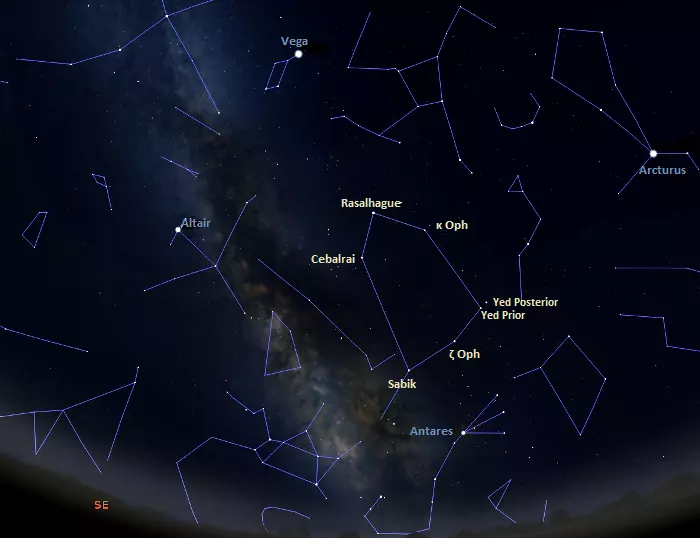
The location of Zeta Ophiuchi, image: Stellarium
Zeta Ophiuchi can be used to find Messier 107, a relatively bright (mag. 7.9) globular cluster in the southern part of Ophiuchus. M107 lies 2.75 degrees southwest of the star, in the direction of Fang (Pi Scorpii), the southernmost star of the Scorpion’s claws.
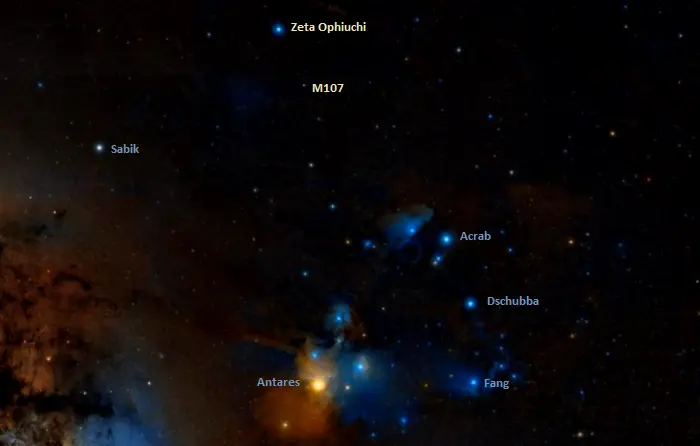
Zeta Ophiuchi and Messier 107, image: Wikisky
Constellation
Zeta Ophiuchi is located in the constellation Ophiuchus. Ophiuchus is the 11th largest constellation in the sky. It stretches across an area of 948 square degrees. It is one of the 15 equatorial constellations, visible from most locations on Earth for at least part of the year.
The Serpent Bearer is one of the 48 Greek constellations, listed in Ptolemy’s Almagest in the 2nd century CE. In Greek mythology, it is associated with the healer Asclepius and depicted as a man holding a serpent, represented by the constellation Serpens. The constellation’s brightest star, the class A subgiant Rasalhague, shines at magnitude 2.07 and marks the Serpent Bearer’s head.
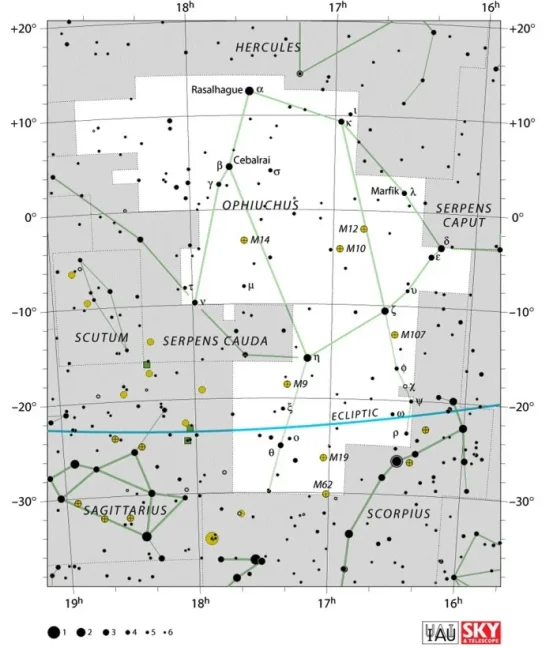
Ophiuchus constellation map by IAU and Sky&Telescope magazine
Despite not having any first-magnitude stars, Ophiuchus is easy to make out in the sky. It contains five stars brighter than magnitude 3.00 that form a large polygon that occupies much of the space between Antares in the constellation Scorpius and Vega in Lyra.
Ophiuchus is best-known for its bright star clusters and for being home to Barnard’s Star, the fourth nearest individual star to Earth (after the three stars in the Alpha Centauri system). Other notable stars in the constellation include the star system Rho Ophiuchi, surrounded by one of the closest star-forming regions to the Sun (the Rho Ophiuchi region), the nearby red dwarf Wolf 1061, home to three known extrasolar planets, and the recurrent nova system RS Ophiuchi. Ophiuchus also hosts Kepler’s Supernova (SN 1604), the remnant of a Type Ia supernova observed in 1604.
The best-known deep sky objects in Ophiuchus include the open star cluster IC 4665 and the globular clusters Messier 9, Messier 10, Messier 12, Messier 14, Messier 19, Messier 62, and Messier 107. The constellation also contains the Twin Jet Nebula (M2-9), a bipolar planetary nebula also known as Minkowski’s Butterfly, the large Dark Horse Nebula, and the ultraluminous infrared galaxy (ULIRG) NGC 6240.
The best time of the year to observe the stars and deep sky objects in Ophiuchus is during the month of July, when the constellation is high above the horizon in the evening sky. The entire constellation is visible from locations between the latitudes 80° N and 80° S.
The 10 brightest stars in Ophiuchus are Rasalhague (Alpha Oph, mag. 2.07), Sabik (Eta Oph, mag. 2.43), Zeta Ophiuchi (mag. 2.569), Yed Prior (Delta Oph, mag. 2.75), Cebalrai (Beta Oph, mag. 2.75), Kappa Ophiuchi (mag. 3.20), Yed Posterior (Epsilon Ophiuchi, mag. 3.22), Theta Ophiuchi (mag. 3.26), Nu Ophiuchi (mag. 3.332), and 72 Ophiuchi (mag. 3.73).
Zeta Ophiuchi
| Spectral class | O9.2 IVnn or O9.5 V |
| Variable type | Gamma Cassiopeiae and Beta Cephei |
| U-B colour index | -0.857 |
| B-V colour index | +0.032 |
| Apparent magnitude | 2.56 – 2.58 |
| Absolute magnitude | -4.2 |
| Distance | 366 ± 8 light-years (112 ± 3 parsecs) |
| Parallax | 5.8287 ± 1.0226 mas |
| Radial velocity | -9.00 ± 5.5 km/s |
| Proper motion | RA: + 27.661 ± 1.683 mas/yr |
| Dec.: +37.195 ± 1.216 mas/yr | |
| Mass | 20.2 M☉ |
| Luminosity | 74,100 L☉ |
| Radius | 8.5 R☉ |
| Temperature | 34,300 K (30,700 – 39,000 K) |
| Age | 3.0 ± 0.3 million years |
| Rotational velocity | 400 km/s |
| Surface gravity | 3.58 cgs |
| Constellation | Ophiuchus |
| Right ascension | 16h 37m 09.5220443145s |
| Declination | −10° 34′ 01.707529156″ |
| Names and designations | Zeta Ophiuchi, ζ Oph, 13 Ophiuchi, HD 149757, HR 6175, HIP 81377, BD−10°4350, SAO 160006, FK5 622, GC 22332, GCRV 9547, PPM 231915, PLX 3775.00, ALS 14820, EUVE J1637-10.5, JP11 2780, GSC 05632-01042, MCW 562, UBV 14047, IRAS 16343-1028, 2MASS J16370954-1034014, AAVSO 1631-10, TYC 5632-1042-1, Gaia DR2 4337352305315545088 |